A lacrosse head is the piece of plastic that sits on top of the lacrosse shaft (the actual “stick” part of the lacrosse stick). A typical head is 10 inches long and weighs somewhere between 4.5 and 6 ounces. The shape of a lacrosse head is vaguely reminiscent of an upside down pear and consists of a solid outer frame and a softer inner set of strings and mesh.
Lacrosse heads can be further sub-divided into about a half dozen component parts. The many variations in how these parts can be, and are, designed is the reason why there are so many different lacrosse heads on the market. The head is what most influences the way a lacrosse stick behaves on the field, and slight adjustments can have big benefits for particular styles of play.
- Basic Characteristics
- Material: Plastic
- Length: 10 in.
- Weight: 4.5-6 oz.
- Main Parts: Frame, Mesh, Strings
Table of Contents
Features of a Lacrosse Head
What are lacrosse heads made of?
The short answer is, plastic.
More specifically, most lacrosse heads are made of nylon. This is true of the frame itself as well as some of the strings and some types of mesh. Even more specifically, some frames and mesh are infused with blends of other plastics like propylene and polypropylene to give them different strength, weight, and stiffness profiles.
Lacrosse head parts
Lacrosse heads can be further sub-divided into about a half dozen component parts. The variations in how these parts can be, and are, designed is the reason why there are so many different lacrosse heads on the market: slight adjustments can have big benefits for particular styles of play.
Scoop
The scoop of a lacrosse head is so-named because it is the part of the head that allows players to “scoop” up balls from the ground. The area just below the scoop is known as the “mouth” of the lacrosse head. Generally speaking, the wider the scoop and mouth are, the easier it is to pick up ground balls and catch airborne balls. Other more subtle variations that make subtler differences on the field have to do with the shape of the scoop itself–how flat or curved it is, for instance.
Mesh and strings
Inside the frame of the lacrosse head rests a diamond-patterned mesh that is anchored to the frame via a set of strings: 4 thin nylon strings for the top, sides, and bottom, and usually a couple of “shooting strings” across the mouth to add more shape to the “channel” through which the ball releases from the head when thrown. Mesh and strings can be bought separately or in sets and some heads can be purchased with the mesh and strings already attached.
The exact configuration of how the strings are woven through the mesh and knotted will strongly influence the shape and placement of the “pocket” of the lacrosse head, which is where the ball rests when carried by a player. The identity of the pocket will in turn influence everything from ball control to the accuracy and velocity of passes and shots.
Different pocket styles each come with many benefits, as well as their own drawbacks, and this potential for creativity and personalization of equipment is one of the most unique and exciting aspects of men’s lacrosse!
Sidewall
The sidewalls of the lacrosse head are exactly what they sound like: the two sides of the frame. The holes of the sidewall–most typically numbering in the 12-20 range on both sides–are where the strings are threaded and knotted. Different sidewall shapes determine the optimal point of where the pocket should be placed, so some heads are designed for players who prefer high pockets and others are designed for those who prefer low or mid level pockets. But these are not hard and fast rules and it’s perfectly possible and common enough to have a high pocket on a head with a low optimal point and vice versa.
As a very simple introduction, high pockets enable quicker releases and allow players to pass and shoot faster, while low and mid pockets increase the amount of ball control a player has.
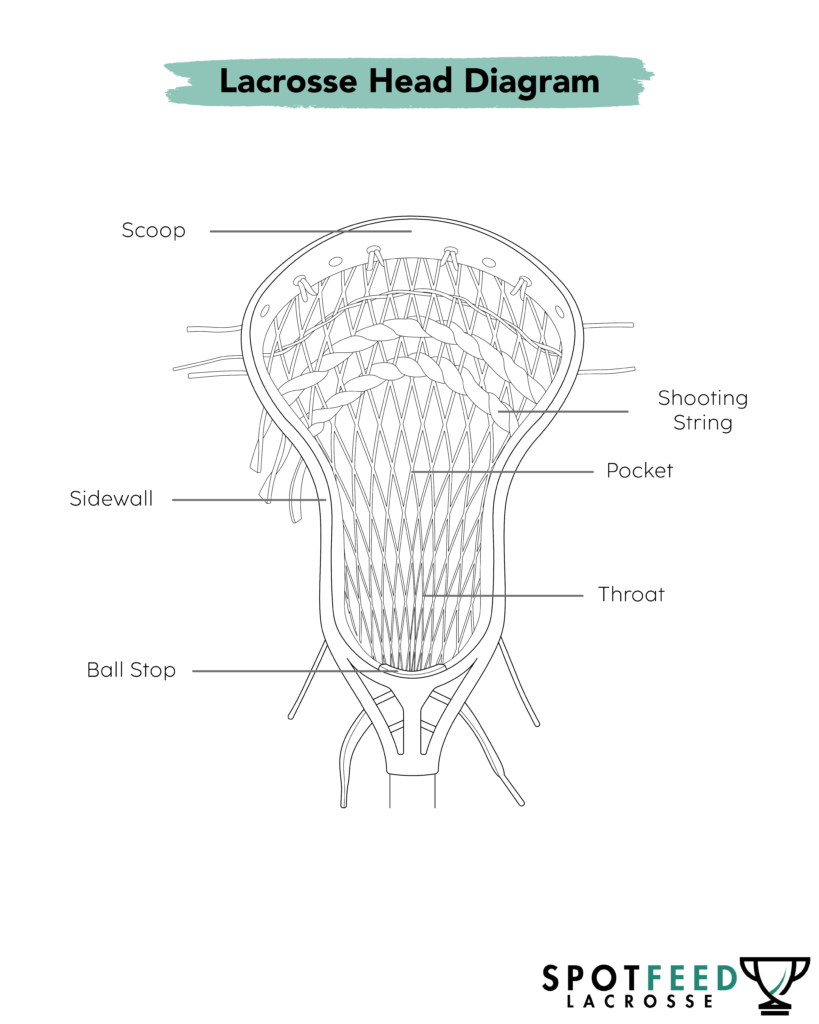
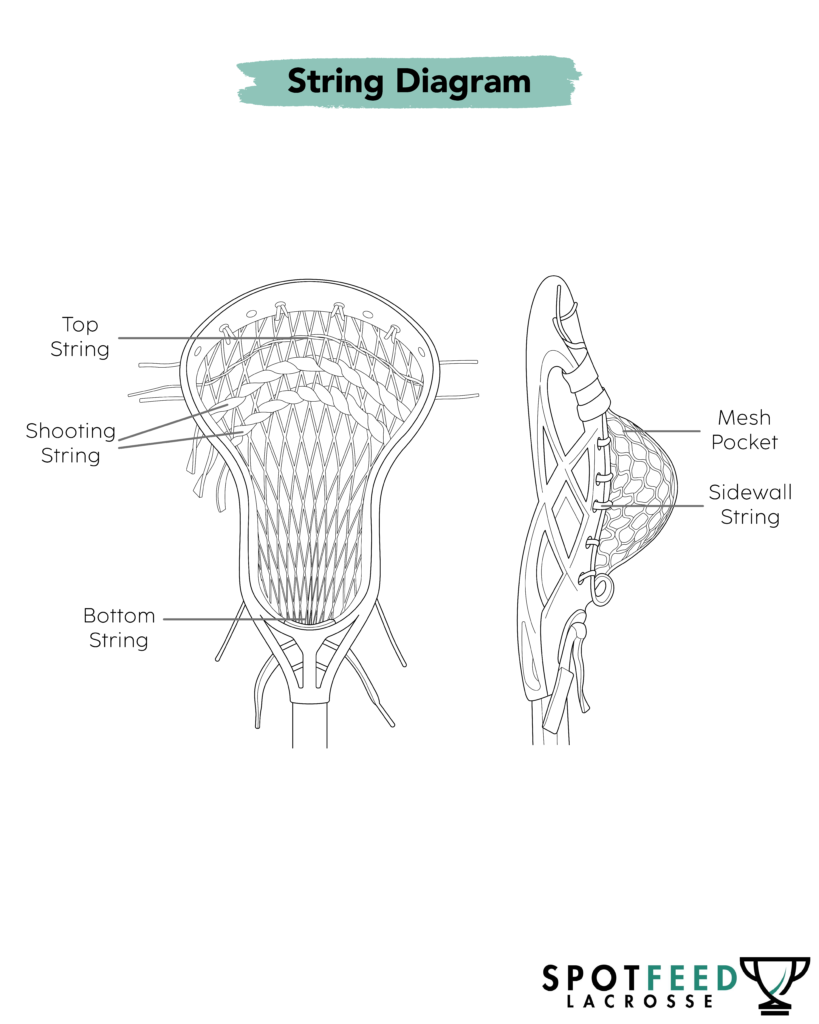
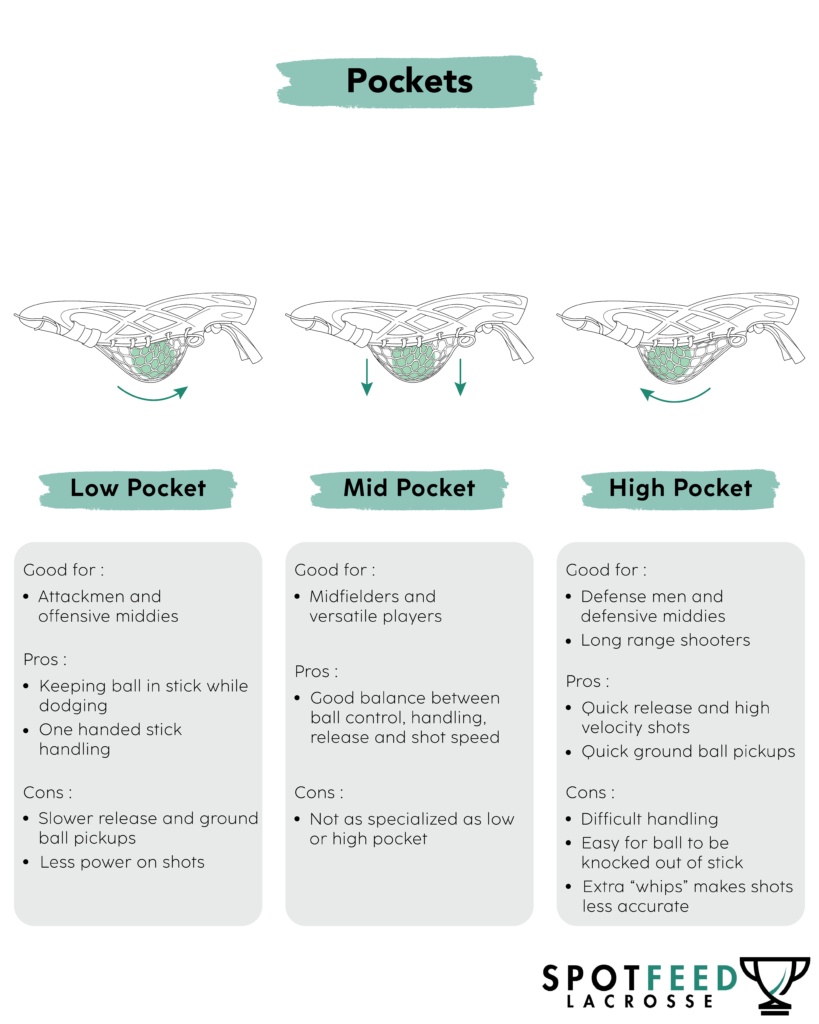
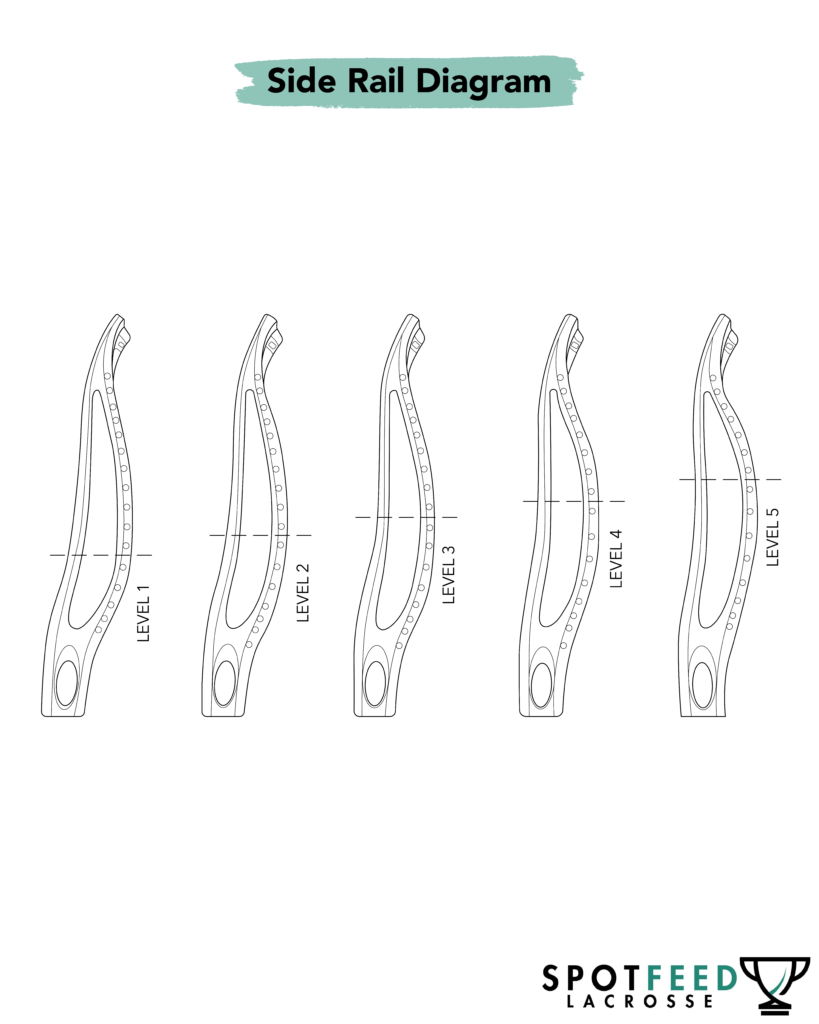
Throat
The throat of the lacrosse head is the bottom part of the plastic which connects to the shaft of a lacrosse stick via a screw. Usually lacrosse heads and shafts come with pre-drilled holes, so it’s just a matter of lining them up properly and using a screwdriver to attach them. Not all heads and shafts fit perfectly, but there are ways of mitigating those issues.
Across heads, throats vary in terms of length and the degree of what’s known as “offsetting.” Generally speaking, short and offset throats increase ball control a bit. These design variations have become more widely available on the market with new releases, but they only provide relatively minor impacts and for most players are not super important.
Ball stop
The ball stop, well, stops the ball. Lacrosse balls are usually made of vulcanized rubber and they are quite bouncy on solid surfaces. So the ball stop acts as a bit of a cushion that prevents the ball from bouncing off the plastic surface of the throat. Is that a common scenario? Not exactly, but it doesn’t hurt to have one and just about all lacrosse heads do.
Buying a Lacrosse Head: Tips and Information
Price
Men’s lacrosse heads vary widely in price. A head can cost anywhere from $20 to $100+ depending on the following factors:
- Who it’s designed for: Just as there are lots of different types of lacrosse players, there are lots of different types of heads. Heads designed for young, inexperienced players will cost less than those designed for elite players seeking more advanced features.
- How new it is: As new technologies become available, lacrosse manufacturers–STX, Warrior, Nike, etc–will release completely new heads as well as updated versions of old heads (there are, for instance, currently 3 different iterations of the Nike Lakota head). This means that an elite head that used to cost $120 when it was first released might be available for $70-80 a few years later.
- Strung or unstrung: Lacrosse heads can be purchases strung or unstrung, meaning that if you prefer not to go through the effort of stringing a head on your own, you can buy one that’s factory-made to be fully equipped with mesh, strings, and a pocket. Because of these extra materials and the extra service, a strung head will cost more than its unstrung equivalent. The exact difference in price will vary by retailer, but typically you can expect to pay around $30-50 more for a strung head.
By comparison, it will cost about $15-30 for a decent stringing kit that includes all the materials you need to fully string a head on your own. Keep in mind, it is DIFFICULT to string a head on your own if you’ve never done it before, so paying a bit extra to go strung over unstrung is definitely worth considering for beginners. It will save you some hassle and can ensure your head will work correctly.
Position
When you first start shopping for men’s lacrosse heads, you’ll quickly notice that many heads are designated as corresponding to particular positions: attack, defense, midfield, goalie. Choosing a head that’s specialized for your position can provide many benefits on the field, enhancing your ability to dominate the competition. Below is a quick overview of factors that matter for each position, but for a more in depth description, check out our lacrosse head buying guides (links below).
Legality
There are a few different criteria that determine whether or not a men’s lacrosse head is deemed legal and they vary according to level of play (youth, high school, college). When buying a head, the main criteria to take into account is the dimensions across the face of the head (see diagram below).
The good news is that you likely won’t have to worry about measuring this yourself. Why? Most online retailers will advertise the legality of their products, usually under “specifications.” If it’s legal for youth and high school play, it will say “HS” or “NFHS.” If it’s legal for college, it will say “college” or “NCAA.” And if it says “Universal” or “U” or “X,” this means it’s legal at all levels of play. And if you’re shopping in a physical store, someone there should know which heads are legal for your needs.
If you’re new to the sport, this is all you need to know about legality when buying a head. For more experienced players, and for those who wish to string their own heads, check out our full guide on equipment legality(coming soon).
Best lacrosse heads for beginners
The best heads for new players are usually cheap, light, and have wide scoops/mouths. You don’t need anything fancy or expensive when starting out and for young players who are still developing physically, a light head can be easier to handle. Lastly, the wide scoop design makes it easier to pick up ground balls and to catch passes.
Best lacrosse heads for attack
Offensive players, particularly those who play attack, handle the ball a lot. They will be served best by narrower lax heads, which improve control and accuracy, allowing them to dominate around the goal.
Best lacrosse heads for defense
Those who wish to play defense need a head that is especially tough and durable, able to withstand the high volume of stick checks associated with this position.
Best lacrosse heads for midfielders
If you play in the midfield, you’ll be spending a lot of time in transition and will be called upon to perform a variety of offensive and defensive functions. You want a head that provides the perfect balance of light weight (for moving quickly and dodging well in transition), accuracy (for taking outside shots), and durability (for doling out and enduring stick checks).
Best lacrosse heads for goalies
There’s nothing stopping an offensive player from using a defensive head or vice versa. But goalie is the one position for which a special head is necessary. A goalie head is much larger than others, providing more surface area for saving shots.
Best lacrosse heads for goalies
There’s nothing stopping an offensive player from using a defensive head or vice versa. But goalie is the one position for which a special head is necessary. A goalie head is much larger than others, providing more surface area for saving shots.
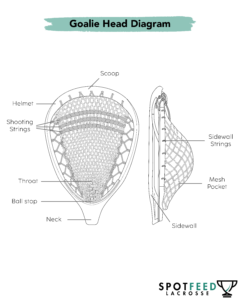
Legality
There are a few different criteria that determine whether or not a men’s lacrosse head is deemed legal and they vary according to level of play (youth, high school, college). When buying a head, the main criteria to take into account is the dimensions across the face of the head (see diagram below).
The good news is that you likely won’t have to worry about measuring this yourself. Why? Most online retailers will advertise the legality of their products, usually under “specifications.” If it’s legal for youth and high school play, it will say “HS” or “NFHS.” If it’s legal for college, it will say “college” or “NCAA.” And if it says “Universal” or “U” or “X,” this means it’s legal at all levels of play. And if you’re shopping in a physical store, someone there should know which heads are legal for your needs.
If you’re new to the sport, this is all you need to know about legality when buying a head. For more experienced players, and for those who wish to string their own heads, check out our full guide on equipment legality.
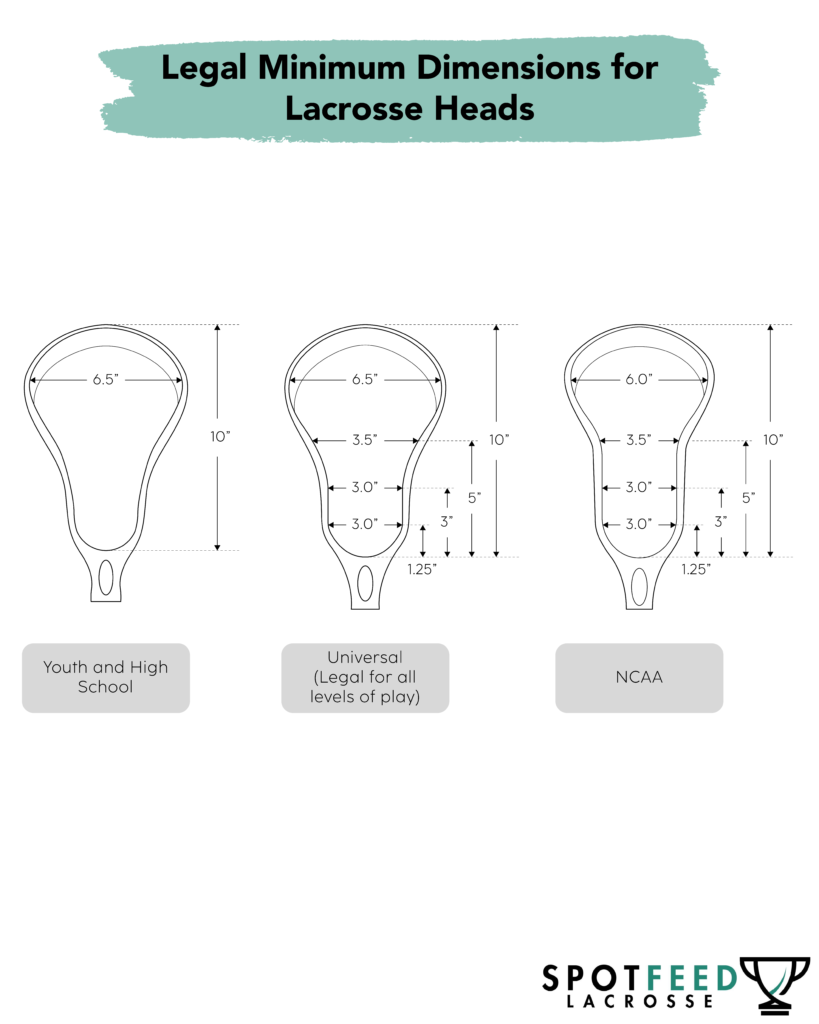
FAQs
The best lacrosse head for a given player will vary depending on that player’s position, preferences, and other factors. But generally speaking, the best lacrosse heads are made by a few major lacrosse equipment brands: Warrior, STX,
Lacrosse heads differ according to a variety of factors such as weight, stiffness, face shape, and the mesh/strings used to make the pocket for the head. Variations in these factors determine certain trade-offs in how a lacrosse head, and ultimately the stick as a whole, performs. For instance, a narrow face shape might improve accuracy and handling, but will also make it a bit harder to catch passes.
Pro lacrosse players often use the latest models of lacrosse heads from top brands such as Warrior and STX, as they are constantly innovating to optimize the performance of their top-end products. What really distinguishes the heads that pros use, though, is their unique stringing styles. Many pro players have tutorials on YouTube where they explain the methods and rationale behind the way they string their heads.
Lacrosse heads range in cost from around $30-40 on the low end to $100+ on the high end, with a mid-tier price range of around $60-80. In general, the cheaper heads are designed for beginner players, while the more expensive ones have nuanced improvements that will only really benefit advanced players. Lacrosse brands are also constantly updating their catalog of heads with new models each year, so you can look to get a slightly older model of an expensive head for a more reasonable price. In many cases, the models from one year to the next will not vary too much, so this is a good way to save some money without sacrificing too much on quality.
